
 October 31, 2017 - Bunk Trailers vs Roller Trailers; Which Is Best?
October 31, 2017 - Bunk Trailers vs Roller Trailers; Which Is Best?
Steve Penkoske Wrote; "Jeff, What kind of trailer do you prefer, a bunk or roller?
A) Steve, if I was assured that every landing I would ever use had water depths adequate for floating my fiberglass 208 ProV, I would absolutely prefer bunk trailers.
Bunks provide better support for my hull and given that I have enough water to float my boat, the bunk trailer is an absolute dream to load. Hands down, the bunks are a better way to go, when and if they suit your needs.
They do have one drawback and it’s a big problem for me because not all of the public access sites at the lakes I fish provide water that’s deep enough to provide adequate flotation.
That's why I still have my Lund Alaskan resting on its Shoreland’r all roller trailer. The beauty of this rig is that I can fish on any lake that has a landing, no matter how shallow it is. That means that I can drive to lake I’ve never fished before fully confident that I will be able to get my boat onto the water.
There’s really no drawback in using a roller trailer with an Aluminum boat, but typically, they are not recommended for fiberglass boats. So if you have an Aluminum boat, fish a variety of waters and shallow landings are likely to cause trouble; then I’d suggest rollers.
If you prefer the comfort of a glass boat or you have a heavier Aluminum model and typically have plenty of water to work with, then you cannot go wrong with the bunk trailer.
If after reading this, you could go either way and you’re still on the fence; consider this. Roller trailers are much more sensitive to level positioning at boat ramps. In order to get my boat positioned correctly on the roller trailer, I need to be sure that I’ve placed it in a level position on the ramp.
At many ramps, this is no trouble, but there’s always that problem ramp that requires multiple attempts. So if all other things were equal, I’d choose the bunk trailer simply to eliminate this single problem.
 Lake of the Woods, LOW Tourism October 31, 2017
Lake of the Woods, LOW Tourism October 31, 2017
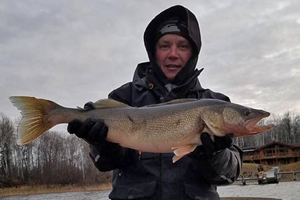 "The walleye bite continues strong as a taste of winter weather moved in over the weekend! Hearty fall anglers finding good fish. On the main lake, anglers sorting through a lot of fish and finding nice keepers mixed in with small. Walleyes are staged in front of Pine Island, Graceton Beach, Zippel Bay, Long Point, and near the gaps in 7-30'. Most anchored up with jig and shiner. Pink, pink/white and gold colors good starts. Fish setting up nicely for ice anglers.
"The walleye bite continues strong as a taste of winter weather moved in over the weekend! Hearty fall anglers finding good fish. On the main lake, anglers sorting through a lot of fish and finding nice keepers mixed in with small. Walleyes are staged in front of Pine Island, Graceton Beach, Zippel Bay, Long Point, and near the gaps in 7-30'. Most anchored up with jig and shiner. Pink, pink/white and gold colors good starts. Fish setting up nicely for ice anglers.
Rainy River holding walleyes of all sizes. Frontier and Clementson area holding fish and shiners still along with a few miles up river from Wheeler's Point. Schools of shiners coming into river randomly still with walleyes close behind. Vertical jigging tipped with a shiner while anchored is the go to method but reports of anglers trolling crankbaits with good success east of Baudette. Smallmouth bass, pike, sturgeon and crappies showing up daily.
Up at the Northwest Angle, Walleyes are biting anywhere from 10 to 30 ft with jigging being the most effective method. Crappies are biting in deep holes of 27'+ with a good amount of perch mixed in. Fish moving to wintering areas and the feed bag is on." – Lake of the Woods Tourism, (800) 382-FISH
![]() Lake of the Woods, Border View Lodge October 31, 2017
Lake of the Woods, Border View Lodge October 31, 2017
"We are wrapping up the charter season. It has been another great year! Thank you to everyone who made the soft water season great! The fishing has been strong, better catches have been coming from the river and Four Mile Bay than previous weeks. There were a few days of strong north wind which dropped the temperature but definitely stirred up the south shore. There should still be plenty of time for it to settle before the ice season starts.
There are still fishing opportunities, we have cabin rental available through November for those wanting to fish from their own boats. The bar and restaurant will be closed after tonight until we start the ice season. Our new Executive Chef Dan Patterson will be working on new menu and the staff will be ready to go when the ice season starts.
The surface water temp has dropped this past week, the snow had to make an impact as we are now in the 40’s.
We will continue to work on projects and remodels at the lodge this November, we have already done new flooring in 6 of the units and have another one down to the studs for a complete remodel.
Don’t forget to book your winter ice fishing trip! The Winter Rates are published on our website. Be sure to make your reservation early to get your choice of dates and take advantage of this great deal: Book your Sleeper House reservation for a Midweek stay by November 30th and receive 10% off." - 1-800-776-3474 Border View Lodge
 Jeff Sundin Fishing Report October 30, 2017 "Wrapping It Up For The Season; NOT!"
Jeff Sundin Fishing Report October 30, 2017 "Wrapping It Up For The Season; NOT!"
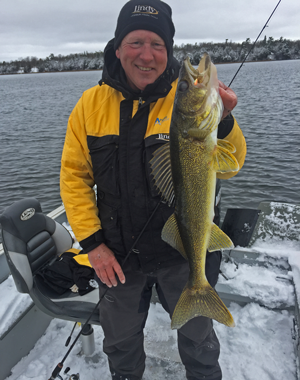 I know that I should be happy to call it quits for the 2017 open water fishing season, but I’m not. Even with snow on the ground and the deer hunting season starting this weekend, I can’t make myself be ready to quit fishing.
I know that I should be happy to call it quits for the 2017 open water fishing season, but I’m not. Even with snow on the ground and the deer hunting season starting this weekend, I can’t make myself be ready to quit fishing.
It doesn’t help that my last scheduled trip of the fall went off without a hitch; well almost.
The Espesets, Bob and Paul have been fishing with me a long time; I’m not sure when they first started, but I can find their names in the books going all the way back into my formative years. Drew came along later and then his wife Rachel later still, but they’ve been here enough to be woven into the collection of fishing stories as well.
We were supposed to fish on Friday, but Mother Nature said “NO”. Even the most committed anglers wouldn’t have lasted 2 hours if we’d tried it. Strong gusty winds, below freezing temperatures and spitting snow made that day uninhabitable for humans in small fishing boats.
Still cold, but much calmer, Saturday’s forecast appeared to offer better conditions for staging a late season rally, so we re-scheduled and luckily, the results were good. In fact, I’m pretty sure that we’d all agree; this year’s fishing trip will get its own special chapter in the Espeset’ s family collection of stories about fishing up north.
The surface water temperature was 47 degrees and stable. Weed growth remained thick for this time of the season, but green weeds were less abundant. Turning black and dying off, weeds were less hospitable to the fish. It was apparent that fish avoided the large weed flat itself; those that we caught showed a preference for the steeper breakline located several yards outside of the weedline.
Before we began fishing, I had mentioned that Tulibee moving into their fall spawning territory could impact our fishing on this trip. It did and was evidenced by the appearance of several Northern Pike that were well above average size. In fact, one of the pike, caught by Paul turned out to be his largest ever. Later, in the fish cleaning shack, I found partially digested Tulibee in two of the Pike that we bagged.
 There didn’t appear to be any direct correlation between the presence of Tulibee and Walleyes that we caught. Most of the Walleyes we bagged did not have many small fish in their stomachs. The fish that did have “food” in their stomachs had been feeding on small Perch that were about 1 to 2 inches long.
There didn’t appear to be any direct correlation between the presence of Tulibee and Walleyes that we caught. Most of the Walleyes we bagged did not have many small fish in their stomachs. The fish that did have “food” in their stomachs had been feeding on small Perch that were about 1 to 2 inches long.
We did catch a half dozen larger fish, but protected by the slot limit, those fish were released without knowing what they were feeding on.
Our minnows were primarily large Fatheads; in fact these are the largest I’ve seen in many years. Available, at least temporarily at Fred’s Bait in Deer River, these big fatheads rival any other minnow you can get your hands on. If I could always find minnows like these, then they would be all I would ever need to catch Walleyes during spring and fall in the Itasca Region.
Even though we were using big minnows and fishing in water depths of 13 to 15 feet, we used 1/16 ounce Lindy Live bait Jigs to deliver them. In the cold water, walleyes reacted slowly to our baits and light weight lures allowed us to fish slow enough to entice strikes and the large, wide gap hooks provide plenty of clearance for good hook penetration.
By allowing the slow moving fish to chew on the minnows for 20 to 30 seconds, our hook setting ratio was good. But if we moved too fast, we could easily snatch the baits away from the fish. We did not have to feed line to the fish, but allowing plenty of time for them to eat the bait before attempting hook sets was essential.
By days end, we managed a bag of 25 keeper size Walleyes. That allowed the Espesets to travel home with their 4 person limit and provided me with one nice fish that paired up with a few panfish for dinner at my house too.
With temperatures in the low 30 degree range, it was far from warm on the lake. But thankfully the wind was light and staying warm wasn’t all that hard. In fact I’m certain that most of us would agree that ice fishing on a day like this would be easily managed.
All things considered, it was a darn good day and maybe that’s why I’m reluctant to call it quits for the season.
I did meet Mother Nature half way though; I’m gonna sit out a couple of days while she snows and blows. OH and the Pro V is cleaned up and put away for winter too. The Alaskan on the other hand is still connected to the truck and ready to spring into action on short notice. So don’t be too surprised if there’s more fishing news after this current cold snap passes. Whatever happens, you will be the first to know! ![]() - Jeff Sundin 218-245-9858 or EMAIL
- Jeff Sundin 218-245-9858 or EMAIL
 Jeff Sundin Fishing Report October 27, 2017 - "Wrapping The Wrapable?"
Jeff Sundin Fishing Report October 27, 2017 - "Wrapping The Wrapable?"
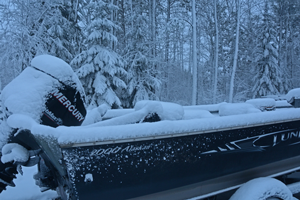 It was fun while it lasted, but the hammer dropped yesterday on our fabulous October fishing weather.
It was fun while it lasted, but the hammer dropped yesterday on our fabulous October fishing weather.
The cold snap got here just a little too soon for me, because today was scheduled to be my last official trip of the season. In light of the weather, we postponed it until tomorrow because the weather forecast appears to offer “doable” conditions. But even if the breeze is calm and the sun does shine, Saturday’s predicted high temperature of 36 degrees probably won’t seem very high.
In preparation of today’s trip, we did squeeze in a short reconnaissance trip on Thursday afternoon. While I’m not sure that I learned enough to help anybody with ideas about fishing this weekend, I did pick up a little knowledge and here’s what I’ve got.
Surface water temperatures ranged from 47 to 48 degrees and by looking at the outside conditions, I expected to find a significant loss of vegetation. The weed growth had thinned since my last visit, but we were surprised to find that were still lots of weeds and many of them remained green.
The remaining green vegetation continued to host some of the lakes gamefish. Northern Pike weren’t too hard to come by; we caught a few Perch too and there were some clues that Walleye were present.
Clues like some finicky pick-ups, a few of skinned minnows and a couple of missed hook-sets made us think that we might be on the right track. The problem is that we only boated one “whitetail” and by the time we did, the rains had arrived, the wind was blowing and my fingers were crying uncle. After a couple of drifts, we were on our way back to the comfort of a nice warm truck.
I’m looking ahead to the forecast for early next week and I don’t see many opportunities for fair weather fishing on the horizon. Precipitation combined with lows in the teens and highs in the 30’s hardly seems like the recipe for crowded boat ramps. For most anglers, fall fishing is likely over now for the rest of this open water season.
There will be some exceptions though. Walleye fishing on the Rainy River typically remains good well into November. Ice anglers can use November as a time to explore fresh territory before freeze up and some of us live close enough to the lakes to take advantage of unexpected opportunity on short notice.
Before long, the buzz will be ice about fishing, but as long as we have open water, I’ll continue posting updates as they become available. ![]() - Jeff Sundin 218-245-9858 or EMAIL
- Jeff Sundin 218-245-9858 or EMAIL
 Jeff Sundin Fishing Report October 21, 2017
Jeff Sundin Fishing Report October 21, 2017
 I’ll bet you’ve been wondering; “Is that boy ever gonna take a day off?” Yes, I AM! In fact, I’m taking a few of them off starting with today.
I’ll bet you’ve been wondering; “Is that boy ever gonna take a day off?” Yes, I AM! In fact, I’m taking a few of them off starting with today.
But first, here’s one last update about Cutfoot and Winnie before I go off the grid.
On Friday, surface readings in some areas of Cutfoot Sioux fell below 50 degrees as reflected by my Humminbird. The high end surface temperature reading was 51.9 and that was already cool enough to worry me that the fall shakeup was in the works. But here’s the interesting part, before the day was over, I would observe low end temperatures of 48.5 to 49 degrees. Despite warm air temperatures and plenty of sunshine, the surface readings fell throughout the day.
I’ve never seen anything like this happen in person, but I think that we might have been first hand witnesses to the event that we know as “the fall turnover”.
Obviously it’s not a scientific study, but my observation was that there appeared to be a correlation between the cooler temperatures and the temperament of the fish.
We were able to locate Walleyes in many of the same spots that I’d fished over the past few days. We were able to get strikes too, the fish wanted to feed, but they were very tentative about holding on to the baits. We tried our hardest to compensate for their foul attitude, but still missed numerous hook sets and lost fish that we did hook on the way to the boat.
Let’s just say that the turnover did occur, that’s good news because now we can breathe a sigh of relief. That’s because after the initial shakeup occurs, fish will begin to re-group and the action will pick up again before freeze up.
Let’s say that this was not the turnover, maybe we just got hit with a zinger and the fish were just “off the bite” on Friday. Then the weather forecast for today should be helpful for the rest of you who will be fishing this weekend. Overcast skies will definitely help, but remember too that the importance of fishing during the evening twilight will be heightened. Instead of fishing early in the day, it will likely be better to start your trip late and stay out until dark. Those last 45 minutes of daylight can sometimes make your whole day.
For the moment, the point is moot for me because I can’t be on the water for a few days.
Don’t worry, the open water fishing season isn’t behind us yet and the reports will keep coming. I still have some fishing scheduled for next week and if Mother Nature keeps sending this crazy warm weather we may be fishing well into November. However those days turn out, you will be the first to know. Good Luck !! ![]() - Jeff Sundin 218-245-9858 or EMAIL
- Jeff Sundin 218-245-9858 or EMAIL
 October 20, 2017 - Tiller Steering vs Console Steering
October 20, 2017 - Tiller Steering vs Console Steering
Pete Mayer wrote; "I read your article about controlling a tiller boat in big waves, it makes sense, but not all of us are lucky enough to have a boat like yours. So my questions are do you really need a tiller boat and what would you do in these situations if you didn’t have one?"
Answer) Pete, you’re right, I am extremely lucky to be able to fish in my 208 Pro V. It is big and comfortable and I don’t think there is any boat on the market today that could possibly make my job easier.
In my situation, holding the boat on fish for my customers is mandatory, I have to accomplish that goal 100% of the time. With that in mind, I stick with the tiller because I realize that sooner or later, there will be a day when conditions dictate that a tiller is the only way for me to do that.
Having the 208 has been a real blessing because it is so comfortable. But, I grew up with Pro Vs, and not all of them were as big or as glorious. I eventually began using Alaskans too, one of which I still own. From the humble beginning, every single one of my boats has been a tiller and the system I described yesterday has worked equally well using all of them.
That said; I know that there are good reasons why families prefer boats with steering wheels and windshields. I don’t argue that choice either; there are lots of fabulous, comfortable and fishable wheel boats out there too. Under different circumstances; I’d love to sit behind a nice full windshield.
I’ve watched a lot of folks fish with console boats and in windy conditions, the shortfall usually centers on boat speed. Many have displayed a tendency to “troll” the boat parallel to the breakline, when they should be “slipping” at an angle that allows them to use the waves to help control the drift.
I could come up with more than one solution, but the easiest and fastest would be using a drift sock. The size of your boat dictates how large the sock should be, but for the conditions I described, I’d suggest using one that’s larger than the suggested norm. To assure maximum effectiveness in extreme conditions, you may even need two drift socks, one in the bow and one at the stern.
To accomplish the quartering effect that I described, you’ll want to put the largest sock on the bow of your boat. The drag will effectively force your boats bow to face into the wind. Now you can use your bow mounted trolling motor to pull the nose into the waves just enough to help slow your speed into fishable range.
If the angle becomes too steep, your anglers may have trouble keeping their lines in fishable territory. That’s where the 2nd drift sock; probably a smaller one would be deployed off of the stern. Experiment with the placement until you learn what your boat likes, you will be amazed at how subtle changes make big differences.
The fishing scenario I described yesterday was fairly extreme, lots of wind and big waves. Under those circumstances, a large, heavy duty drift sock works best and I have Drift Control’s “Magnum Series” for that. Mine is a 48 inch, but there’s a 60 inch available that will definitely slow down the most unruly fishing boat. For less extreme conditions or when a 2nd sock is required, I have Drift Control’s “Fisherman’s Series” 30 inch sock. This one is incredibly handy and simple to use. I have mine connected to the boat at all times and use it frequently.
Going back to the original scenario, your intention should be to find locations where the waves push your boat at an angle toward the shoreline. Your trolling motor, depending on the model, may not provide adequate thrust to pull heavy current. If not, use your outboard to provide the needed push.
There are times when I leave my outboard in gear, at slow idle speed to provide assistance to my trolling motor which I use to steer the boat. The outboard provides power; the electric provides the “fine tuning”.
I hope this gives you some ideas about where to start. I’m sure that readers have more ideas too and I would love to share them, shoot me an email. ![]() - Jeff Sundin 218-245-9858 or EMAIL
- Jeff Sundin 218-245-9858 or EMAIL
 Jeff Sundin Fishing Report October 19, 2017 - Cutfoot Sioux Pre-Turnover Walleye Action
Jeff Sundin Fishing Report October 19, 2017 - Cutfoot Sioux Pre-Turnover Walleye Action
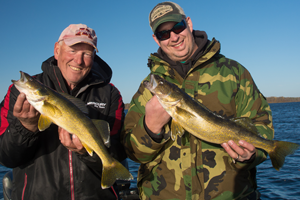 Familiar territory for thousands of anglers, Cutfoot Sioux has of late, been living up to its reputation as a reliable fall walleye destination. Recently, the fishing action has proven that she’s still got what it takes to stir up a smile for fall walleye fishermen.
Familiar territory for thousands of anglers, Cutfoot Sioux has of late, been living up to its reputation as a reliable fall walleye destination. Recently, the fishing action has proven that she’s still got what it takes to stir up a smile for fall walleye fishermen.
Surface temperatures on Wednesday were 51.5 degrees when measured on my Humminbird and 54.5 degrees on the submersible pool thermometer. Strong west winds churned the surface and whitecaps pounded the shoreline along Battle Point. There was some debris floating on the surface consisting primarily of floating leaves, but also included vegetation from the lake, uprooted by the current.
My observation, based on past experience was that the lake had not “turned over”, at least not yet. That opinion would be further supported by the solid fishing action that we encountered in a variety of locations around the lake.
Hoping to expand on what I’d learned on Tuesday, I returned to the weed edges along Cutfoot’s west shoreline. We started off with a bang there, Grady and Gary both pulled in plump slot-fish, and then those were followed up by nabbing a few “keepers”; we were off to a good start.
The next couple of stops had me worried though, the west side of the lake had gone calm. Tuesday’s south wind had that side of the lake churned up and that encouraged the fish to move. But after the wind shifted from south to west, the encouragement was gone, calm water and sunshine left this stretch of shoreline inhospitable for walleye fishing.
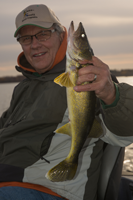 I was hopeful that I could find a few spots where the whitecaps would be an advantage and after I sized up a stretch of shoreline that would provide a quartering wind, it was time to go over to the windy side and check it out.
I was hopeful that I could find a few spots where the whitecaps would be an advantage and after I sized up a stretch of shoreline that would provide a quartering wind, it was time to go over to the windy side and check it out.
Please allow me to stray away from the fishing report for a moment. I have to because this is one time when “how to” is more important than “where to”.
The term “quartering wind” means a location where the waves are striking the shoreline at an angle. The ideal angle allows me to hold the transom of my boat into the waves to help slow down my drift, while still allowing the boat to drift on a course parallel to the shoreline. The best angles lie somewhere between 30 and 60 degrees, but I can work outside of that range when I have to.
The point is that I’m using the wind to help me control the boat; I am not trolling, nor am I just drifting along with the wind. Call it slipping, controlled drifting, whatever term you like, just understand that this is pro-active boat control.
Admittedly, under these conditions, a boat jockey’s work is never done. But those whitecaps are my friends, they are ideal for making the walleyes bite and because I know that walleye fishing success is 90% dependent on boat control, I am willing to do whatever it takes to get the job done. Getting the right combination of boat speed, depth control and fishing line management is what makes a plan come together.
Ideally, I will hold the boat speed down to around .6 to .8 MPH and I will be able to use my trolling motor to position the boat at any depth along the breakline. That allows my crew to put their lures in front of fish and gives them enough time to illicit a strike and make a proper hook set.
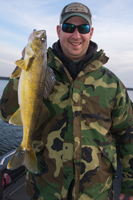 There are a lot of ways to float a boat and many of them work well for catching fish under “normal” circumstances. But sooner or later, every walleye angler will be tested by conditions like this and that’s why I believe in tiller operated boats for walleye fishing. I believe that there are times when a walleye fisherman’s entire day will depend on the advantage provided by this method of boat control.
There are a lot of ways to float a boat and many of them work well for catching fish under “normal” circumstances. But sooner or later, every walleye angler will be tested by conditions like this and that’s why I believe in tiller operated boats for walleye fishing. I believe that there are times when a walleye fisherman’s entire day will depend on the advantage provided by this method of boat control.
Don’t get me wrong, if you do not have a tiller boat, you can still catch fish with a bow mount. You’ll just need to extrapolate enough information from the facts I’ve shared to fine tune a system that works for you.
Sorry for that detour, back to the fishing report.
From here on out, we bounced from one submerged point to another, finding a few fish at each location. If there was a mother lode anyplace, we didn’t stumble into it. On the other hand, I cannot recall stopping anywhere that did not provide us with a few strikes.
For me, fishing the weedlines has been a mainstay for the past several weeks and I stuck with the weed pattern on Cutfoot too. Our key depth was 10 feet, which kept our lures very close to the weeds, but without getting snagged in them constantly.
The presentation probably sounds pretty familiar; we used the 1/8 ounce Live Bait Jigs tipped with minnows. Fatheads, Golden Shiners and Lake Shiners all worked fine, I don’t think that the fish showed a preference.
While we fished the weed pattern, there were others who did not. One of the well-known local guides was fishing on the lake too and focused on deeper water. From what I could see, they fished deeper points and submerged mid-lake bars exclusively.
I don’t know exactly how that worked out for them, but I can say that he/they have been sticking to that pattern for the past two days. That tells me that the confidence level is high enough to make it worth consideration.
 I’ve tried my hand at writing about the fall turnover and what it really is over the past few years. Even though I still don’t have a 100% grasp of the process, I experienced that there is a period when the fish populations congregate and become very aggressive. Unfortunately, that period is followed by a time when they scatter and become much harder to locate and catch.
I’ve tried my hand at writing about the fall turnover and what it really is over the past few years. Even though I still don’t have a 100% grasp of the process, I experienced that there is a period when the fish populations congregate and become very aggressive. Unfortunately, that period is followed by a time when they scatter and become much harder to locate and catch.
On Cutfoot, I felt like we were in the pre-turnover stage, the time when fish are both feeding aggressively and fairly easy to locate. We were able to catch enough keeper fish to send the crew home with their limits and I even had a spare one for my own dinner. Along the way, we released a dozen or more protected slot fish and we also tossed back a couple of little tykes.
When will it change, today, tomorrow, after the weekend? I’m not sure.
Admittedly, the fishing conditions were ideal on Wednesday and that's why I'm cautious about giving this advice. But I will say that the odds look favorable for one more weekend of reliable action.
I know that it’s not much fun trying to chase down somebody else’s “hot bite” and last thing I want to do is send you on a wild goose chase. But because there are so many variables, it’s difficult to predict the right place and trickier still to predict precisiely the right time. But if you haven’t put your boat away and you’re in the mood for one last ride on the lake, this could be the time to do it! ![]() - Jeff Sundin 218-245-9858 or EMAIL
- Jeff Sundin 218-245-9858 or EMAIL
 Jeff Sundin Fishing Report October 18, 2017
Jeff Sundin Fishing Report October 18, 2017
I fished Cutfoot Sioux for Walleyes on Tuesday and I it wasn’t too bad. I promise that you’ll get an update tomorrow morning. But limited by time, today’s report will focus on reader comments and questions that came in via email yesterday.
 October 18, 2017 Chris Cass - Question About Leech Lake
October 18, 2017 Chris Cass - Question About Leech Lake
Question) "Are your fishing reports coming off Leech Lake? I am coming up there this weekend and trying to gauge the fishing trends."
Answer) Chris, yes there are some reports with information that is specific to Leech Lake. On October 14, 2017 and October 12, 2017 I fished the lake myself, so those reports both contain firsthand information about Leech.
Area wide, the trend this week has been stability; warm, sunny days are discouraging water temperatures from taking the next big plunge.
Weeds of certain varieties have decayed, but Coontail, Cabbage and Eelgrass remain viable and are still a healthy green color. If you’re fishing in fairly calm conditions, then I’d search weed flats until I found the fish that I’m looking for.
When the wind blows though, it is very typical for walleyes to move onto the rocks. Leech Lake is famous for its fall rock bites and if there’s a healthy chop on the water, I would certainly check out some of the more popular rock spots too.
 October 18, 2017 Ted Merdan - Question About Leech Lake
October 18, 2017 Ted Merdan - Question About Leech Lake
Question) "Hi Jeff, We spoke 3-4 years back at the Federal Dam access in late October. I am headed back up there Thursday Oct 19th with my father for a few days of fishing through the weekend. I have been looking through your reports and trying to piece together a plan for our trip. We are planning to fish mainly portage bay area, unless the forecasted winds really limit us.
Are there any depth ranges we should target? Also, what is the condition of the weeds up there? Should we be focusing on that area or more towards hard bottom (rock/sand) areas? Any other pointers that you could send our way are appreciated.
One additional question, is there anywhere in the area, assuming that we have some success, that would cook fresh fish for us? We will be staying in the Longville area.
Answer) Ted, I think you can pull most of the information out of my answers to Chris’ previous question.
Expanding on that though, I will say that we have not been focused on Portage Bay. We’ve fished primarily in Sucker Bay, with some forays into Agency Bay, Ottertail Point and the Walker Narrows.
The predominate depths have ranged between 10 and 12 feet and my typical approach to finding fish is to troll or drift with light, 1/16 ounce Lindy Live Bait Jigs tipped with big minnows. Fatheads, Rainbows and Shiners in the 3-1/2 to 4-1/2 inch range are working much better than smaller minnows.
It seems logical that the fish would be active in weeds on the east side of the lake too, but it’s been a couple of weeks since I’ve heard from anybody who’s shared firsthand knowledge. So I’ll defer to anybody who’d like to add their 2 cents worth and maybe I can post a quick update on Thursday morning.
About your fish fry; When I want to entertain somebody with a meal of fresh fish, my travel pattern takes me east of Leech Lake. The Gosh Dam Place, located on Highway 46 and County Road 9 is famous for their customer supplied fish dinners. Another good spot is in Deer River, at The Outpost located on Hwy 2, west of town.
There are certainly other choices, so to help find someplace closer to Longville, I'll throw the question out to our readers. Can anybody help Ted out with a suggestion for a good fish fry in the greater Longville area?
 October 18, 2017 - Rainy River Walleye Run
October 18, 2017 - Rainy River Walleye Run
Comments) Jeremy Lawrence Wrote; Good morning, my dad, brother and I are going to fish the Rainy, maybe LOW, the 26th-28th of Oct. Dad and I are driving up from KS and my brother is flying down from Anchorage. We hope to catch the shiner run. We have never fished this lake or the river so it will be an adventure.
I want to offer a special thank you for your advice on fishing deep water. I fell into the "ignorant" category, and though we are after table fare, we will certainly keep your suggestion in mind. The last thing we want to do is kill a fish that has an opportunity grow.
Answer) Thank you for the comments Jeremy!
The timing of your trip should be pretty darn good. Even if the fish are not engaged in a full scale migration upriver, there will certainly be fishable numbers of walleye in the river. The rest of the fish should be easily accessible on Lake of the Woods and are typically located within a few miles either side of the gap.
In the past, I’ve noted that there’s a strong late afternoon bite for fish on the big lake. Lake of the Woods is not noted for an after dark bite, but an hour before sunset can really be good.
I hope that your trip is fabulous, Good Luck ![]() - Jeff Sundin 218-245-9858 or EMAIL
- Jeff Sundin 218-245-9858 or EMAIL
 October 2017 - Help Jeff Sell The Boat and Receive Free Fishing Weekend!
October 2017 - Help Jeff Sell The Boat and Receive Free Fishing Weekend!
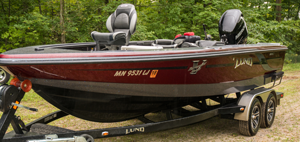 That's right, this is a fabulous boat and I love it! But it’s getting close to the end of the season and it's time to make room in the shed for ice fishing stuff, that means that my boat is ready for a new home and you can get a free fishing trip for helping sell it.
That's right, this is a fabulous boat and I love it! But it’s getting close to the end of the season and it's time to make room in the shed for ice fishing stuff, that means that my boat is ready for a new home and you can get a free fishing trip for helping sell it.
You, or someone you know can cash in on big savings by picking up this rigged, ready and fully trained in luxurious fishing boat for $15,000 below the retail price.
If you’re reading this page, then you already know that I like to ... Learn More >> Lund 208 ProV GL Tiller For Sale
 Jeff Sundin Fishing Report October 17, 2017 - "Family Day On The Lake"
Jeff Sundin Fishing Report October 17, 2017 - "Family Day On The Lake"
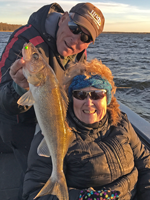 The wind maybe was a little bit harsh for our family friendly fishing trip on Monday. But it’s hard to argue that any mid-October day featuring temperatures in the mid 60’s isn’t a lucky one!
The wind maybe was a little bit harsh for our family friendly fishing trip on Monday. But it’s hard to argue that any mid-October day featuring temperatures in the mid 60’s isn’t a lucky one!
Lucky too was that somehow my wife, my mother, my brother and his girlfriend all managed to land on the same day off so that we could fish together on this blustery, but otherwise gorgeous day.
I’m not sure that I’d call this a “Hard Core” fishing report, because that’s the last thing I’d call our afternoon fishing trip. But we do have some observations that may be useful for you if you’re planning to fish a little bit more this week.
The surface water reading was 51 degrees on my Humminbird and with whitecaps churning the water, readings were consistent over most of the lake.
Weeds, where we found them in shallow water, were mostly decayed and their color was more black than green. The exception was one patch of Coontail that held more of its green color, but even that patch was losing the battle against fall.
When we fished jig and minnow combinations along the weed edges, we did find a few walleyes scattered at random intervals, but I did not see evidence that there was any large schools of walleye present in the shallow water.
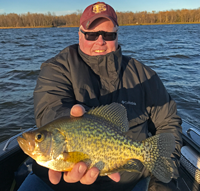 As we moved around deeper water in search of panfish, the screen of my graph was filled with images of small fish and clutter caused by all of the turbulence. It was hard to decide when to stop because there were so many schools of small somethings on the screen. When we did stop to test schools of fish, they were small, very small.
As we moved around deeper water in search of panfish, the screen of my graph was filled with images of small fish and clutter caused by all of the turbulence. It was hard to decide when to stop because there were so many schools of small somethings on the screen. When we did stop to test schools of fish, they were small, very small.
Many of the schools consisted of Crappies in the 6 inch range, at least that’s mostly what struck our baits. There were other fish that showed up on the screen and they appeared to be larger, but they were both scattered and suspended. I marked numerous individual fish that were holding 12 feet below the surface over water that was 22 feet deep.
Suspended fish aren’t that hard to catch when they are grouped in larger schools. Targeting single fish that are suspended tends to be tricky, especially in 2 foot whitecaps; it’s just hard to know that your lure is in the right place to illicit a strike.
Judging by the random appearances of single fish suspended everywhere over deep water combined with the random nature of fish encounters along the shoreline, I’d say that it’s likely that this lake had “turned over”. I’m using the term “turned over” to describe the time when fish are no longer bound to stay in any one habitat or any particular food source within the lake. The time when decaying weeds encourage fish to move out into open water and when oxygen in shallow water lakes becomes mixed up enough so that fish can go anywhere they please.
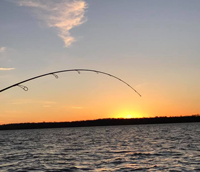 The timing of this coincides with the trends I’ve mentioned earlier this week, like evening walleye feeding runs and the like.
The timing of this coincides with the trends I’ve mentioned earlier this week, like evening walleye feeding runs and the like.
From here on out, fish location is likely to be unpredictable and that’s what could be mistaken for slow fishing action. In my experience, fish will bite when you find them, but because they are scattered, finding them will take longer.
That, combined with cooler water temperatures adds fuel to the notion that fishing for walleye during the evening bite will be the best strategy for the rest of this week.
Panfish are likely to remain in late fall/early winter haunts from now until freeze up. So fishing for them is liable to be the main focus of my daytime fishing, while walleyes will occupy the twilight period.
So there you have it, even a low-level family fishing trip can produce a few anecdotal observations from the lake.
OH and I almost forgot the highlight reel. My mother, AKA Lady Virginia caught the biggest walleye, but Cyndee actually caught the first one. My beautiful wife, AKA the “Hippie Chick” caught the only keeper northern and my brother Gary caught the best Crappie of the day while I put on a clinic for anybody who wants to learn how to catch 6 inchers.
It reminded me of the days when I was a lucky kid going fishing with the family. Nobody “hammered ‘em”, but we all caught something and at the end of the day, a family fish fry winds up on the agenda. Amazing how that works, isn’t it? ![]() - Jeff Sundin 218-245-9858 or EMAIL
- Jeff Sundin 218-245-9858 or EMAIL
 Lake of the Woods, LOW Tourism October 17, 2017
Lake of the Woods, LOW Tourism October 17, 2017
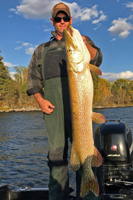 "The walleye bite remains strong! Report is very similar to last weeks. Walleyes are staged in front of Pine Island, Graceton Beach and Zippel Bay in 18-30'. Anglers sorting through a few small fish for every keeper. Most anchored up with jig and shiner. Pink, pink/white and gold have been the best colors. Reefs holding fish as well.
"The walleye bite remains strong! Report is very similar to last weeks. Walleyes are staged in front of Pine Island, Graceton Beach and Zippel Bay in 18-30'. Anglers sorting through a few small fish for every keeper. Most anchored up with jig and shiner. Pink, pink/white and gold have been the best colors. Reefs holding fish as well.
Rainy River anglers finding success up and down the river. Schools of shiners coming into river randomly right now. When they do, the walleyes are close behind. Some days excellent, some days catching fish but not a slam dunk based on whether shiners are moving through. Vertical jigging tipped with a shiner while anchored is the go to method. Some anglers trolling crankbaits with success as well. Smallmouth bass, pike and crappies showing up.
Up at the Northwest Angle, in MN waters walleyes are crushing jig and shiners. Orange and chartreuse were the hot colors this week. Big pike being caught trolling minnow baits. In Ontario waters, minnow/shiner have been effective off of points at depth of 18-26' while anchored or trolling. In addition to walleyes, crappies on fire and jumbo perch active! Some muskies being caught trolling." – Lake of the Woods Tourism, (800) 382-FISH
 Jeff Sundin Fishing Report October 16, 2017 - Fall Fishing Update
Jeff Sundin Fishing Report October 16, 2017 - Fall Fishing Update
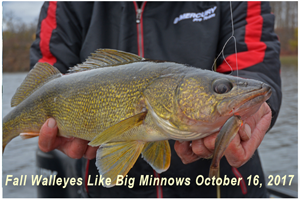 Surface water temperatures remain above 50 degrees on most area lakes. The most common readings now range between 51 and 54 degrees with deeper waters trending higher than shallow lakes.
Surface water temperatures remain above 50 degrees on most area lakes. The most common readings now range between 51 and 54 degrees with deeper waters trending higher than shallow lakes.
Grand Rapids area Walleye fishing reports haven't varied from what I wrote yesterday. The trend toward evening feeding patterns continues and most anglers who fish the “evening bite” are bagging some fish.
It’s been a while since I’ve mentioned the size of minnows that we use during the fall.
The fattest fatheads, most rounded rainbows and chubbiest chubs will produce more fish than any skinny minnow. While there are certain minnow species that I would prefer over others, my decisions about which ones to purchase are based on size.
This year, there was a limited supply of really big fatheads, they were 3-1/2 to 4 inches long and they worked like a charm. If I could always find those, then that’s all I would ever use. But I can’t, so I’ll take rainbows, golden shiners, spottails, dace, whatever I can get as long as they fall within that size range, somewhere close to 4 inches.
Walleye fishing on Lake of the Woods continues strong according to friends who fished the Zippel Bay area this weekend. There were lots of fish ranging in size from 10 inches, up to fish in the low 20 inch neighborhood.
Driving the action are Emerald Shiners making their way toward the Rainy River. Local sources say that there are shiners trickling into the river in small waves, but so far the mass migrations of them has not begun.
Walleyes tend to be lazy on LOW and in some ways, the less you do with your lure, the better it will work. The secret is to locate slight irregularities in bottom contours. The preferred presentation was a typical cold water fishing pattern for Lake of the Woods; anchor the boat and fish jig and minnow combinations close to the bottom.
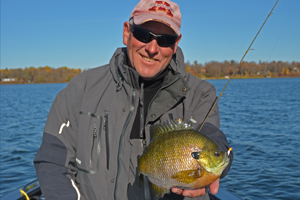 Small inside turns, soft rises and subtle holes provide ambush points for walleyes that lay in wait to feed on the migrating shiners. Even seemingly irrelevant changes in depth or bottom content will provide enough structure to make a difference.
Small inside turns, soft rises and subtle holes provide ambush points for walleyes that lay in wait to feed on the migrating shiners. Even seemingly irrelevant changes in depth or bottom content will provide enough structure to make a difference.
Based on my own experiences, daytime fishing for panfish, bluegills in particular continues to improve. I’ve received several reports from friends who agree that the pursuit of panfish has been rewarding in terms of both numbers and average size.
I think it’s natural for anglers to follow fish that migrate into deep water holes. The combination of seasonal timing, decaying weeds and low light does provide ideal habitat for panfish. Add to this that fish are much easier to spot on your graph in deep water and it adds up to an obvious choice.
Fishing in deep water has consequences though, serious ones and from what I’ve seen on social media lately, there are still a lot of folks who could stand to move further up on the learning curve.
If you plan to harvest fish and you’re willing to bag the first fish that strike, regardless of size, then there’s no problem. Fish that are going to be served for dinner don’t require protection from me or anyone else. But if you’re planning to release some of the fish that you catch, let me offer an alternative.
Try targeting shallow water lakes that have strong panfish populations, but do not have deep, mid lake basins.
In my territory, there are numerous examples of lakes no deeper than 20-25 feet that provide plenty of opportunity for quality panfish. If I catch a big Bluegill in 20 feet of water and want to release it, I can breathe a little bit easier, knowing that the odds of survival are better than if I’d caught it in 30 feet.
Fishing in 20 feet of water still doesn’t let me completely off the hook either. I still have to handle the fish carefully, but at least I’ve improved the odds of seeing that fish again. Better yet, I’ve increased the odds that this big bull will do his job next spring and help the lake keep producing quality ‘gills.
I know, I’ve been reminding you a lot lately and there’s a good chance that you already “get it”. I am sorry for repeating the stump speech again. The problem is that there are still a lot of folks who haven’t read these reports and many of them are innocent, they don’t even realize that there’s a problem.
There are others do, but they justify releasing fish caught in deep water because they believe that there are some “tricks” that make it feasible.
If you’re in the latter group, then all I ask is that you demonstrate a willingness to learn. If you’re in the former group, then maybe you’d be willing to help spread the word? All it takes is to mention that sadly, most of the so-called tricks really don’t help. Damage to internal organs that we don’t see can mean that even when a fish swims away, apparently unharmed, their chances for survival are low.
The longer that fish remain in “deep water” the harder it is to release them safely. That means that the importance of being diligent becomes even more important during the ice fishing season.
The weather forecast for this week looks awesome and the fish are biting right now. This gives me a great idea, why not do a little research, single out a few good panfish lakes that feature shallower water and test them out now? The payoff might be better than you’ve imagined possible and odds are good that you’ll find a good spot to drill your first holes after freeze up. ![]() - Jeff Sundin 218-245-9858 or EMAIL
- Jeff Sundin 218-245-9858 or EMAIL
 Jeff Sundin Fishing Report October 15, 2017 - "The Power To Persevere"
Jeff Sundin Fishing Report October 15, 2017 - "The Power To Persevere"
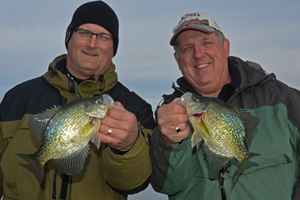 It was nip and tuck, but on Saturday I received my official notice of re-certification as a moderately decent fishing guide.
It was nip and tuck, but on Saturday I received my official notice of re-certification as a moderately decent fishing guide.
Kevin Scott of the “B Minus Guide Service”, an official emissary to the governor’s task force on fishing said; “He was a shoe in for re-certification as a Perch Guide, he sailed through his crappie credential, bass and sunfish didn’t pose any problem either. Walleyes though, he had us a little worried about that.”
Luckily for me, an evening bite on Lake Whispermenot saved the night and I can hold my head up proudly today. I have officially passed the worrisome walleye stage of the testing and my re-certifications papers are “in the mail”.
All joking aside, the walleye have done everything they can to prove the theory that I wrote about last Friday, "Cold Water Triggering Crepuscular Feeding Pattern". As water temperatures continue downward, the daytime action is trending slower and the emphasis on low light feeding periods has intensified.
For late fall walleye anglers, air temperatures make the “morning bite” much less attractive than fishing in the evening, when it’s warmer, so that’s where I invest my time.
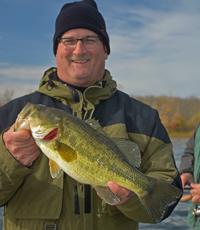 Evening knowing that the likelihood of an evening feeding run was strong, I was getting pretty nervous on Saturday. The fish that showed up early in the evening did not pass muster. Walleye’s in the 10 to 12 inch range were obviously too small and they dominated the action. There were some 14 inchers too, but these fish failed to make the grade for this crew.
Evening knowing that the likelihood of an evening feeding run was strong, I was getting pretty nervous on Saturday. The fish that showed up early in the evening did not pass muster. Walleye’s in the 10 to 12 inch range were obviously too small and they dominated the action. There were some 14 inchers too, but these fish failed to make the grade for this crew.
Solid size fish in the 16 to 19 inch range did not appear on the scene until 6:30, after it was almost dark. During a half hour feeding run, we had picked up a couple of dozen fish, 5 of which were good keepers and that was enough to declare victory.
The fish we caught gathered on the tip of a shoreline point that leads from a shallow weed flat all the way down into 40 plus feet of water. When the fish became active, 22 to 26 feet was the magic depth for catching them. Before that, I could pick them on the Humminbird, but they appeared only as faint smudges on the bottom in about 32 feet of water. Apparently, they were lying in the mud, waiting for the right time to feed.
Jig and minnow was all we needed to catch fish, but I did use a wiggle worm for a while and that allowed me to catch a couple of fish too. As the walleyes began to feed though, so did other small fish and my wiggle worm was a target for them too. I switched back to the jig and minnow just because it was less prone to attacks by little perch and the like.
Our morning was easier, Crappies were more than cooperative and we caught them using the same techniques that you’ve read about for several weeks now. So, I’ll save the play by play and if you want to learn more, read the report from 2017, it’s just as accurate now as it was then.
The takeaway from this report ought to be that if you’re looking for a walleye dinner, be sure to plan your trip so that you’re on the water for the evening bite. Even if it looks bad and you’re really discouraged, the fish do show up and they do at times save your trip.
The power to persevere, that’s how I passed my test and now I can look forward to receiving my certificate in the mail. OH, by the way Kevin, you’ll remember to put postage on the envelope; right? ![]() - Jeff Sundin 218-245-9858 or EMAIL
- Jeff Sundin 218-245-9858 or EMAIL
 Jeff Sundin Fishing Report October 14, 2017 "Leech Lake Fishing Update"
Jeff Sundin Fishing Report October 14, 2017 "Leech Lake Fishing Update"
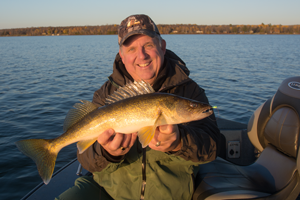 On Thursday I teased you with a photo of my Humminbird that showed big schools of fish, stacked like cord-wood that we’d seen swimming over the weed tops on Leech Lake. I mentioned too that we never gave ourselves enough time to thoroughly establish a pattern to capitalize on the discovery.
On Thursday I teased you with a photo of my Humminbird that showed big schools of fish, stacked like cord-wood that we’d seen swimming over the weed tops on Leech Lake. I mentioned too that we never gave ourselves enough time to thoroughly establish a pattern to capitalize on the discovery.
On Friday I concluded my report with this; “Kevin Scott’s B- Guide Service crew is heading over to fish with me and they are gonna help me unravel more mysteries of Leech Lake; it’s gonna be a good day!”
Well, we went, they did and it was, so to the extent that anybody can figure out Leech Lake in one day, here’s our update.
Conditions were cool and sunny, the breeze was light in the morning, but became stronger during mid-day. Surface water on the lake was 55 degrees according to my pool thermometer and 52 degrees in the opinion of my graph and these reading did not vary during the day.
The fish that I found on Thursday were still hovering over the weeds in water depths of 11 to 12 feet. The blend as evidenced by our morning catch consisted of Perch, Pike and at least one small Largemouth Bass. Walleyes were there too I believed, but that fact could not be proven by us during the morning.
The one size fits all presentation that we used was a 1/16 ounce Lindy Live Bait Jig tipped with any “good size” minnow. As long as they were in the 3-½ to 4-½ inch size range any Fathead, Shiner or Rainbow minnow will work. I realize that these sound like an awful big minnow for jigging, but they are not; at least not during late fall.
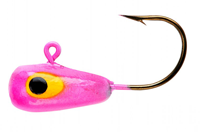 Luckily for me, the presentation worked and produced good perch, typical of what the big lake can cough up. We set our low end target at 10 inches and we were able to add about 30 Perch to our creel. The largest fish were 12 inches and made up about 1/3 of our catch.
Luckily for me, the presentation worked and produced good perch, typical of what the big lake can cough up. We set our low end target at 10 inches and we were able to add about 30 Perch to our creel. The largest fish were 12 inches and made up about 1/3 of our catch.
We caught numerous pike too, but I don’t think that most folks would be too interested in them. The average size pike was small, somewhere between 16 and 20 inches.
There is certain randomness to the fish’s location because of the large size of the weed flats. We literally covered 2 miles of real estate and found schools of fish in various places. Whatever lies on the bottom, within the weed bed is the apparent secret to precision location. Once we located good fish, we’d drop a marker and stay put, most of the fish we caught came from tiny stretches that provided what the fish wanted.
I was disappointed in myself for not having an underwater camera to help me understand what bottom content the fish favored. But I guess we don’t need to know for sure, we only need to know that fish can be found by diligently searching for them.
At about 1:00 PM, I’d heard the word “walleye” mentioned about 30 times and it was apparent that we weren’t going to catch many of them where we were fishing. So I departed the weeds and went looking for something more interesting.
Following conventional wisdom we tried several shallow breaklines and shoreline flats located in some of the most popular areas. There were small groups of fishermen located at many of the spots and by all appearances, they were fishing with determination. I think that most of these folks may have been catching fish earlier in the day, but by the time we arrived the action was over.
The one really interesting discovery was a school of fish that held tight to a steep breakline in 16 feet of water. Once we saw them, I set up for a drift that resulted in catching one slot fish and one nice size Tulibee. It really looked like we’d hit the motherlode and then the breeze died, the lake went flat and the school of fish split up and disappeared.
I was disappointed that we couldn’t get in on that bite when it would have been good, but I was happy to see those fish and as soon as conditions warrant, I’m gonna try to find them again.
By 4:00 Pm, I’d gotten the itch to try and prove that there were walleyes in the weeds, so we returned to the weed flats. This time the walleyes did strike and in short order we bagged 3 good keepers and released 2 more slot-fish and lost 1 fish at the boat. If we’d stayed longer, we may have bagged a few more, but by 6:00 PM there was a definite slowdown in both walleye and perch action.
The upshot for me was that I should never have left the weeds. Just like my episode with Marty last Thursday, the long boat rides in search of something better, never paid off.
That’s the report from my point of view, but I should mention that there’s another opinion. One of the area’s popular guides stumbled into me at the bait shop yesterday and paraphrasing his words; “Leech Lake has been fantastic, but if my customers aren’t getting snagged in the rocks, they are not catching fish”.
So take that for what it’s worth, we all know that if there’s a wind, Leech Lake is very capable of providing great action on the rocks. I was just too far away from a good rock spot to check that out on Friday, but it’s worth keeping in your back pocket for the next breezy day.
Today the careful tutelage of the “B Minus Guide Service” continues. Kevin and Al will direct me to the Promised Land of small water Crappie and Walleye fishing. Without doubt, they will live up to their motto; "changing lives, one fish at a time". ![]() - Jeff Sundin 218-245-9858 or EMAIL
- Jeff Sundin 218-245-9858 or EMAIL
 Jeff Sundin Fishing Report October 13, 2017 - Cold Water Triggering Crepuscular Feeding Pattern
Jeff Sundin Fishing Report October 13, 2017 - Cold Water Triggering Crepuscular Feeding Pattern
 Cooler water temperatures may be forcing a change in walleye feeding habits. Anecdotal evidence is mounting and it appears that the duration and intensity of feeding periods is diminishing.
Cooler water temperatures may be forcing a change in walleye feeding habits. Anecdotal evidence is mounting and it appears that the duration and intensity of feeding periods is diminishing.
Cold blooded critters like fish, in this case walleyes, have less incentive to feed when their body temperature goes down. As the fishes body temperature cools, their metabolism gets slower and that reduces the requirement for them to consume food as often.
At the same time, shallow weeds are dying off and bait fish have moved further away from predictable locations. As the baitfish move away from the weeds, suspending over open water becomes an important strategy for their survival. This tends to discourage predators from concentrating in predictable territory and the scattering effect makes finding large schools of feeding walleye more difficult.
For anglers, these later fall patterns mean that expecting fish to strike all day long is becoming less realistic. Since fish don’t need to feed as often, it makes sense that we should prepare to focus on prime feeding periods, particularly the evening twilight.
I’m bringing the subject up because over the past couple of days, I’ve noticed a ratcheting down of both the intensity and duration of walleye feeding periods.
On Thursday, surface temperatures metered in at 54 degrees, which wasn’t cold enough to stop the action completely. However, fish that struck willingly between 9:00 AM and Noon, demonstrated a definite sluggishness at midday. The siesta time slow down came on the heels of recent trips that I described just a few days ago as “easy fishing”; because it was.
Just to prove my theory, I had prepared myself for the notion that we’d be fishing until sunset. My crew had other commitments though and there wasn’t enough time to make that happen, so for now speculation is all I have to offer.
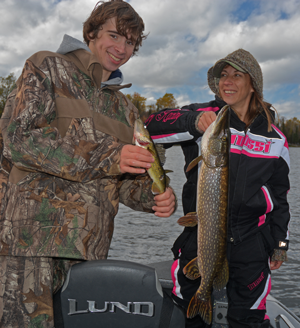 During the time that walleyes were active, our action wasn’t bad. We picked up 8 keepers, released a handful of larger slot-fish and flipped back a dozen midgets too.
During the time that walleyes were active, our action wasn’t bad. We picked up 8 keepers, released a handful of larger slot-fish and flipped back a dozen midgets too.
The reliable fall presentation, Jigs and minnows were sufficient to trigger walleye strikes. But on Thursday, the pike were in “one of their moods” and snipped off more than few of our lures. While not our intended quarry, the pike did continue to provide action during times when the Walleyes slowed down and on this occasion, that was okay.
Thursday’s highlight reel includes an interesting image; one of the pike struck a walleye while Kim was reeling it in.
It’s not that uncommon to hear about a large pike chomping into an innocent walleye that’s headed for the landing net. But it is uncommon for us to actually get both of the fish into the net. But this pike believed that somehow he was going to get that walleye and he refused to give up.
Luckily for the walleye, its small size warranted a speedy release after being rescued from certain death. The pike on the other hand didn’t fare so well and will soon be the center of attention on the dinner table as “Coconut Pike Delight”; I think.
Here we are, its Friday the 13th and while this date might not be portrayed as a lucky, that’s okay with me. I know good luck when I see it, and I have a boatful of it coming my way! Kevin Scott’s B- Guide Service crew is heading over to fish with me and they are gonna help me unravel more mysteries of Leech Lake; it’s gonna be a good day! ![]() - Jeff Sundin 218-245-9858 or EMAIL
- Jeff Sundin 218-245-9858 or EMAIL
 Jeff Sundin Fishing Report October 12, 2017 "Location, Location, Timing"
Jeff Sundin Fishing Report October 12, 2017 "Location, Location, Timing"
 Wednesday was Marty Glackin’s last fishing day up north and Leech Lake was slated to provide the “grand finale” of his 2017 trip. While I can’t necessarily say that it was grand, the finale’ was interesting to say the least.
Wednesday was Marty Glackin’s last fishing day up north and Leech Lake was slated to provide the “grand finale” of his 2017 trip. While I can’t necessarily say that it was grand, the finale’ was interesting to say the least.
Take one look at the photo of my Humminbird and tell me that you wouldn’t love to see this image of fish located smack dab under your boat. The expression “stacked up like cordwood” comes to mind and if our timing had been better, we may have enjoyed a finale’ of mammoth proportion.
We actually found the fish on a sprawling weed flat right away in the morning. At that time the air temperature was 33 degrees and the fish were buried in the weeds. We knew that they were there because we had managed to elicit some strikes, but slow action combined with the constant battle against heavy weeds discouraged me from staying there. So I split the scene to search for something “better” and that’s where I went wrong.
The short story is that I tried shallow water, steep breaklines, rocky points and sandy flats. We fished on the calm side, then we fished on the windy side and the results were the same everywhere; small Pike would strike, but not much else.
It was time to re-visit the only place that had produced fish, at least we knew they were there and maybe we could drag a few more of them out from under the weeds.
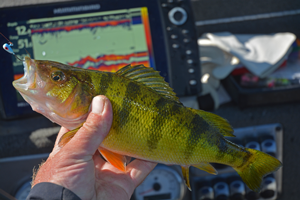 Imagine my surprise when we discovered that they were not buried in the weeds, not anymore. They were holding high above the weed tops and they appeared to be everywhere on the flat. For most of the afternoon, the screen of my graph looked just like the picture you see here. There were fish on the screen constantly and they were becoming active.
Imagine my surprise when we discovered that they were not buried in the weeds, not anymore. They were holding high above the weed tops and they appeared to be everywhere on the flat. For most of the afternoon, the screen of my graph looked just like the picture you see here. There were fish on the screen constantly and they were becoming active.
Heavy jigs were a waste of time; the fish were suspended too high above the bottom. But once we rigged up 1/16 ounce Lindy Live Bait Jigs, tipped them with minnows and began swimming them over the weed tops, we began getting strikes.
There were Perch, Northern Pike, Bass and Walleye all mixed together, we never knew what the next hook set would bring. We caught some of everything, but Perch provided the most action. That was good for us because Marty was in the market for some of those; we hadn’t bagged any Perch during previous trips.
Now that we were on the right track, timing was the problem. We were definitely in the right place, but at the wrong time because Marty had set his sights on an earlier departure. We literally were leaving the lake at the time the fishing was just beginning to get good.
Of course I’ve spent the past 16 hours believing that we would have hammered them if we’d stayed longer. Maybe we would have, maybe we wouldn’t have, either way; it was an interesting way to end the trip to say the least.
Our experience yesterday ties in with other recent reports from Leech Lake. The fish are biting, but you have to first figure out where they are. There are a few anglers catching lots of fish, but there are also a lot of anglers catching few fish.
Exploration combined with good timing will likely result in a good fishing experience. But from what I saw yesterday, it will take some determination to find the right place. ![]() - Jeff Sundin 218-245-9858 or EMAIL
- Jeff Sundin 218-245-9858 or EMAIL
BAROTRAUMA AWARENESS - Rebecca Eberts
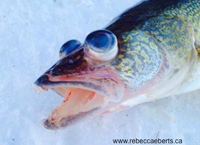 What is barotrauma? Simply stated barotrauma is “injury caused to the body by changing air or water pressure.” In humans we know this as “The Bends”- a dangerous condition that divers experience when they come up too fast from deep water. Believe it or not, something similar happens in fish.
What is barotrauma? Simply stated barotrauma is “injury caused to the body by changing air or water pressure.” In humans we know this as “The Bends”- a dangerous condition that divers experience when they come up too fast from deep water. Believe it or not, something similar happens in fish.
For example: When an angler angles walleye at the bottom of the lake, those walleye are experiencing a certain amount of pressure (air & water). When the angler yanks them up to the surface, that pressure is drastically reduced. This means that their gas filled cavities rapidly expand. This is particularly a problem for fish due to the presence of their ..." Read >> BAROTRAUMA AWARENESS
 Jeff Sundin Fishing Report October 11, 2017 - "Exploring The Explorable; Re-Visited"
Jeff Sundin Fishing Report October 11, 2017 - "Exploring The Explorable; Re-Visited"
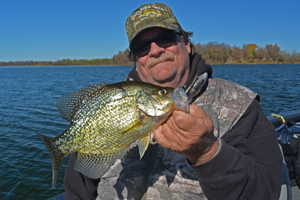 Today, I want to introduce you to a new fishing term; I call it “Minimal Impact Fishing”.
Today, I want to introduce you to a new fishing term; I call it “Minimal Impact Fishing”.
Someone who visits these pages with regularity might recall that I’ve been on a mission to broaden my Panfishing horizon during recent years. Occasionally I post reminders like the report I wrote last September titled “Exploring the Explorable”.
There’s more than one reason to explore new lakes, but for me, the very best one is to ensure that I don’t visit any one lake too often. Over the years I’ve learned, sometimes the hard way that too many visits to the same place can really muck up the waters in a favorite fishing hole. I don’t want to be the one who wrecks a fishing sport for anybody, especially for the fishing customers who depend on me to find special places to visit.
Overall, I’d estimate that my track record of stumbling into really good lakes is about 33%. For every lake I find that offers quality fishing for Crappies, Sunfish or Perch, there’s another one that really stinks and then there’s one more that turns out okay, but isn’t really special.
I know that track record doesn’t sound very good, but I think it is stellar.
Consider this; it doesn’t take all day to check out most of these small waters. Usually we can find what we’re looking for in a few hours, sometimes the fish don’t bite, but at least I can see them on the Humminbird. Once I know if there are fish in the lake, then I’ll know if I should try again at a better time or if I should cross it off my list.
If I do visit a zinger, then often times, a visit to the next lake on the list will produce a more desirable result. So, as it happened in the aforementioned report from last year, the day can be often be saved by visiting “lake #2”.
The mission to discover a broader array of Panfish waters has taken me in a lot of directions, and it’s allowed me to see a lot of really fabulous lakes. But there are none more precious than the one that I discovered a while back when I was fishing with my adventurous nephew Chris Andresen.
I hope you’ll forgive me for not spilling the beans about where it is, but avoiding over-exploitation of these lakes has been the whole point of my mission. My personal goal is to have a minimal impact on the lakes I visit and while we do harvest some fish, we purposely avoid over doing it on any one body of water.
Marty Glackin, a fishing customer and good friend is one of those guys who have the “adventurous spirit”. He knows that I’ll do my best to produce a good fishing trip and he’s allowed me some extra leeway when it comes to experimenting. That’s why yesterday was a good day to re-visit little lake #1113.
Luckily, the weather was nice, the fish were there and we had a great day on the water; but that’s not the point of today’s report. The takeaway, I hope, is that if you’ve been thinking about exploring some fresh territory, now is the time to do it.
The timing for exploration could not be better than it is right now. Surface temperatures have fallen into the mid-50 degree range, shallow vegetation is beginning to die off and Panfish populations over open water are well established. The odds are very good that if you do some research, you will find what you’re looking for, right now and all the way to freeze up.
“Minimal Impact Fishing” means something else too, especially in terms of fishing for Panfish in deep water. Barotrauma is a real problem and it causes extreme injury to a fish that is reeled up from the depths. The deeper that fish are located, the worse the problem is, but be assured that any fish caught over 30 feet of water is literally un-releasable.
If you’re fishing in water over 25 feet deep, this is no time to be selective about the size of fish that you bag. If it’s Crappies you’re harvesting, then take the first 10 fish and be happy, leave the rest alone and then you can catch some of them next time.
If you run into me at the fish cleaning shack and you have a couple of small fish in your pail, don’t worry, I won’t laugh at you, I will pat you on the back!
For me, it’s time to return to the pursuit of Walleye and Perch. I’m hoping that Leech Lake is ready for Marty and me because that’s where we’ve planned our “grand finale’”. ![]() - Jeff Sundin 218-245-9858 or EMAIL
- Jeff Sundin 218-245-9858 or EMAIL
Oh and by the way, you've seen many references to the term Barotrauma. Simply put, it means that any fish that range in the deep water will be vulnerable to anglers who innocently catch and release them without realizing the risks involved with deep water fishing.
Read the article by Rebecca Eberts, "Barotrauma Awareness", it's an excellent article that will help you gain an understanding about fishing in deep water and why we shouldn’t do it.
 Jeff Sundin Fishing Report October 10, 2017 - Countdown To "The Big Chill"
Jeff Sundin Fishing Report October 10, 2017 - Countdown To "The Big Chill"
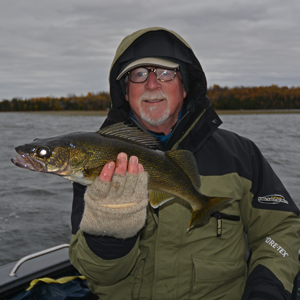 With Grey skies, a hard driving west wind, and air temperatures in the low 40’s, walleye fishing was a little chilly on Monday. It was the first dosage of really cold fishing weather and provided a reminder that I better find a pair of gloves and a warm hat.
With Grey skies, a hard driving west wind, and air temperatures in the low 40’s, walleye fishing was a little chilly on Monday. It was the first dosage of really cold fishing weather and provided a reminder that I better find a pair of gloves and a warm hat.
Surface temperatures varied, but ranged between 53 and 56 degrees depending on where I measured them. I did not get the impression that the water was cold enough to force a walleye feeding shutdown, at least not yet. But with surface water already vulnerable to “The Big Chill”, last night’s hard frost might have been enough to force temperatures down into scary territory.
The “fall turnover” a term that we’ve that used historically to describe the temporary slowdown in fishing action when water temperatures fall too low is on the verge of striking. It’s a tricky event to document because it manifests itself in so many ways, but there’s little arguing the fact that one fabulous week of fishing can end abruptly after the water gets too cold.
I don’t think we were there yet, but an indication that we may be turning the corner was the sluggish attitude of the fish that we pursued yesterday.
After a week of fairly aggressive feeding behavior, walleye’s yesterday fiddled around with our baits, tugging and dropping the lures several times before finally engulfing the minnows. Even after we hooked fish, there was no guarantee that they’d arrive at the net; several fish came un-hooked as they were reeled toward the boat.
The simple fact that we caught fish at all was inspiring though; despite chilly fingers and drippy noses we hung in there and found something to distract ourselves. So the trip ended well, we had some action and bagged a satisfactory creel of keepers.
Today I’m nervous though, there’s always a day that I have to pay the price and this could be the one. On the other hand, there is such a thing as good luck and I’ve had my share of that too. You never know, I might stumble into something cool (no pun intended) on the lake today. Maybe the “Big Chill” will land softly, causing less distress than usual; that would be nice. ![]() - Jeff Sundin 218-245-9858 or EMAIL
- Jeff Sundin 218-245-9858 or EMAIL
 Lake of the Woods, LOW Tourism October 10, 2017
Lake of the Woods, LOW Tourism October 10, 2017
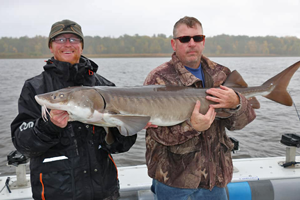 "The walleye bite is on! Walleyes increasing in numbers still along the south shore, Long Point, Zippel Bay, Lighthouse Gap, Four Mile Bay and in river. Anglers picking through small fish to fill live wells with 18-19 inch walleyes. Walleyes have the feed bags on. 18-30 feet holding fish. Anchor up with a jig with a shiner minnow. Pink, pink/white and gold have been the best colors. Reefs holding fish as well.
"The walleye bite is on! Walleyes increasing in numbers still along the south shore, Long Point, Zippel Bay, Lighthouse Gap, Four Mile Bay and in river. Anglers picking through small fish to fill live wells with 18-19 inch walleyes. Walleyes have the feed bags on. 18-30 feet holding fish. Anchor up with a jig with a shiner minnow. Pink, pink/white and gold have been the best colors. Reefs holding fish as well.
Rainy River anglers finding more success each day. Shiners still moving in river. Vertical jigging tipped with a shiner is best method. Some anglers trolling crankbaits with success as well. Smallmouth bass, pike and crappies showing up. Good numbers of sturgeon of all sizes being caught with some over 50" and 60".
Up at the Northwest Angle, in MN waters, jig and a minnow/shiner will fill your live well. Areas of best success between islands in current areas with depths ranging from 13-26.’ Fish are really hungry and are packing on the pounds before ice season! Canadian walleye fishing is also outstanding. Orange, pink or chartreuse with a minnow/shiner have been effective off of points at depth of 18-26.’ Musky action transitioning from shallow reef tops to deeper waters, trolling cranks or jigging big rubber is common practice now. Many smallmouth have been caught this week with wounds from predatory fish." – Lake of the Woods Tourism, (800) 382-FISH
 Lake of the Woods, Border View Lodge October 10, 2017
Lake of the Woods, Border View Lodge October 10, 2017
"The surface water temp in the river is 54.3 degrees this morning. The shorter hours of daylight and cooling temps should allow it to continue to drop. 45 degrees is somewhat of a bench mark on seeing more and heartier shiner minnows.
Our charters have been on the South Shore of Big Traverse all week. Patience pays off, and sorting through many littles ones is the key to a bag of 18-19 inchers. Anglers doing the best are picking their spots and waiting it out rather than a run and gun all day approach. Depths from 22-30 feet have had solid traffic of schools. Still, the gold Strobe Jigs from Tom’s Tackle seem to be the preferred weapon, tipped with a shiner minnow.
We see some frost coming in the forecast with temps ranging from 40’s to upper 50’s for the week ahead. Clear skies are predicted this week.
Our winter rates are published on our website, book early to get the best dates. Here is a great deal on Sleeper Houses for this coming winter. Make your Sleeper House reservation for a Mid-week stay by November 30th and get 10% off." - 1-800-776-3474 Border View Lodge .
 Jeff Sundin Fishing Report October 9, 2017 - Fall Walleye Patterns Holding Steady
Jeff Sundin Fishing Report October 9, 2017 - Fall Walleye Patterns Holding Steady
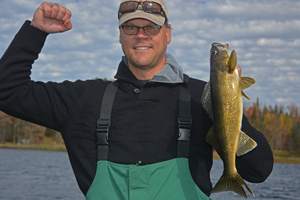 Surface temperatures have fallen squarely below 60 degrees on most lakes. On Sunday, the reading in my boat was 58 degrees, still considered ideal for fall walleye fishing, at least by me.
Surface temperatures have fallen squarely below 60 degrees on most lakes. On Sunday, the reading in my boat was 58 degrees, still considered ideal for fall walleye fishing, at least by me.
Conditions were better on Sunday morning than they were during the afternoon when sunshine and calm seas overtook the morning’s cloudy and breezy conditions.
The difference for us was reflected in a reduction of walleye numbers, with an increase in pike numbers. Walleyes did slow down, but they did not stop biting altogether, so we continued to chip away at them right up until the moment we decided to leave the lake.
Without re-hashing many of the same details that I’ve outlined for most of the past week, I’ll summarize briefly.
Weeds are still a major factor in my daily game plan so our key depths have varied according to the depth of the weeds. In most case, water depth has been 12 to 13 feet, occasionally shallower, seldom deeper.
Jig and Minnow combinations continue to be the only presentation we are using. The minnows I’m using are the largest fatheads I can get and I cannot see any disadvantage using them vs using shiners or other minnows.
 Jeff Sundin Fishing Report October 7, 2017 - "Reading Into Fall Water Temperatures!"
Jeff Sundin Fishing Report October 7, 2017 - "Reading Into Fall Water Temperatures!"
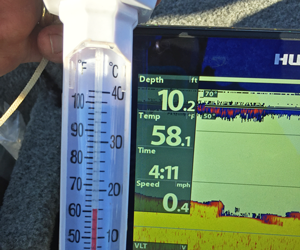 My boat was covered with ice on Friday morning. Sometime during the wee hours, Grand Rapids received the first hard frost of the fall. I think the frost was widespread throughout the Itasca area; I noted that all of the mowed ditches were frosty white along the road to the lake.
My boat was covered with ice on Friday morning. Sometime during the wee hours, Grand Rapids received the first hard frost of the fall. I think the frost was widespread throughout the Itasca area; I noted that all of the mowed ditches were frosty white along the road to the lake.
The hard frost combined with clear skies and calm seas concerned me. After nearly a week of wet, windy weather and steadily feeding fish, this could turn out to be their day of rest. I forewarned my crew that I was taking on a challenging bite, and added that I hoped to make up for slower fishing action with an opportunity for better quality fish. Cautiously optimistic, I headed toward the lake, prepared for a switch to Plan B, if needed.
At the landing, my Humminbird showed that the surface water was a cool 53 degrees. But according to the graph, temperatures were warmer, settling into the 57-58 degree range once we traveled out to the lake’s center.
Take those readings with a grain of salt, because comparing them to the ones which I received from the pool thermometer revealed a 3 degree variation. I’m not sure which of those readings was the most accurate, but I do know that either one of them suggested that we’d still be in the “safe zone” in terms of fish behavior and the likelihood that they’d be active.
At our first stop, a weedy shoreline flat adjacent to a sharp drop off, Tom got the ball rolling quickly; he’d bagged the first Walleye within a few minutes. Soon after, our search was interrupted by a pike and then it took another 15 minutes to bag another keeper walleye. We were off to a start, but it wasn’t a fast one, hoping to find a better spot, I moved toward the edge of another weedy shoreline flat.
At the second stop, things started off the same way, we caught a fish here, a fish there, never more than one or two at a time. But we were catching the quality fish that I’d been hoping for, so nobody seemed to mind spending a little extra time to drum up a strike.
After that bite faded, I spent some time looking at more prominent structures; deeper points and bars that led toward the lakes mid-section. Even though I did spot some fish on the graph, these structures provided little in the way of action. Maybe the fish I marked were not walleyes, maybe these prominent structures have been pressured more, and maybe I just had bad timing. No matter, I decided to “go back to the drawing board” and returned to the weeds where we’d scrounged our fish earlier.
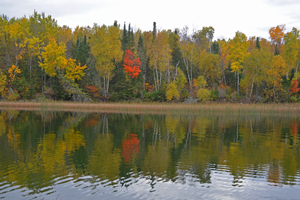 We re-fished the area where we’d caught walleyes earlier, but didn’t drum up very many fish and it seemed at first that returning to the spot was a dumb idea. But as I passed through the area we’d fished before and started roaming further into fresh territory, it became obvious that this was the turning point in our trip.
We re-fished the area where we’d caught walleyes earlier, but didn’t drum up very many fish and it seemed at first that returning to the spot was a dumb idea. But as I passed through the area we’d fished before and started roaming further into fresh territory, it became obvious that this was the turning point in our trip.
The revelation was that walleyes lay scattered along the weed edges in small schools. They were not super aggressive, but they were willing to strike and by constantly covering fresh territory, we amassed a respectable bag of nice fish. The trick, if you want to call it that, was to keep covering fresh water, encountering fish that hadn’t been pursued by anybody yet.
The presentation we used included 1/8 ounce Live Bait Jigs tipped with fairly large minnows. We had a mix of big fatheads, rainbows and golden shiners; fatheads and rainbows worked very well, the “Goldies” didn’t attract as much attention.
Our approach was to creep along the outer edges of the weeds and pitch our lures toward the weeds. We let the bait fall toward the bottom and then hopped, twitched, wiggled and snapped them as we swam our baits back toward the boat. I liken this to Bass fishing along a weedline; in fact we caught some Bass as we fished for walleyes too.
I could see that there are still lots of minnows and small fishes hovering in and around the weeds. I’d be surprised if this pattern doesn’t remain viable for at least a few more days, maybe longer if the weather remains warm.
Thanks to the combination of good fishermen, good weather and good luck, Friday’s trip brought me to the end of one complete week where we fished exclusively with jig and minnow presentations and bagged limits of walleye for my crew on each day of fishing.
If you’ve read the reports recently, then you know that this has been my first “easy” week in a while and I’m thankful for that!
I’ll be focusing on water temperatures and keep you posted daily and while I’m not sure that I can promise another full week of easy fishing, leading indicators are good. So don’t put your boat in the shed just yet, the fish might just surprise us.
 Jeff Sundin Fishing Report October 5, 2017 - "Winner Winner, Walleye Dinner!"
Jeff Sundin Fishing Report October 5, 2017 - "Winner Winner, Walleye Dinner!"
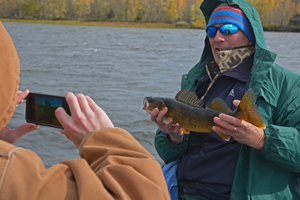 I know that there are a lot of distractions during the fall, but I hope that following these reports for the past week has helped boost your interest in fishing. The downward trend in water temperatures has been good for business, especially for folks in my line of work.
I know that there are a lot of distractions during the fall, but I hope that following these reports for the past week has helped boost your interest in fishing. The downward trend in water temperatures has been good for business, especially for folks in my line of work.
On Wednesday, walleyes not only continued to be cooperative, but I noted a broadening of the range of sizes. There were fish of multiple year classes arguing over who was next to chomp down a Lindy Live Bait Jig and Fathead combo. We caught 10 inch fish, 20 inch fish and every size in between, including enough good “keepers” to send my crew home with their limits.
The areas we fished, steep breaklines adjacent to large weed flats were similar to the spots I fished on Tuesday. But the preferred depth was deeper, instead of fishing in 14 to 16 feet; we fished at 20 to 24 feet. The change in depth seemed related to the appearance of the Sun which appeared on the scene at mid-morning. I had been worried about the predicted sunshine; I thought that it might force a slowdown in the action. Luckily, there was a good chop on the water and fishing deeper water was the only adjustment we had to make in order to catch fish.
The only crystal ball I own is the cheap “Cub Reporter, Junior Model”, so I always get nervous making predictions. But on Wednesday, surface temperatures were hovering in the 58 degree range and I’m optimistic that they’ll linger in this 56 to 58 degree neighborhood for a few days. That means this could be a really good weekend for fishing. ![]() - Jeff Sundin 218-245-9858 or EMAIL
- Jeff Sundin 218-245-9858 or EMAIL
 I know that you have an opinion about fishing in Minnesota. I know too, that there are times when you think nobody cares what it is.
I know that you have an opinion about fishing in Minnesota. I know too, that there are times when you think nobody cares what it is.
Well this is your chance to influence the system, your time to sit right down with “the powers that be” and tell them what you think.
The Minnesota DNR has announced that there will be openings on several of the fisheries species specific workgroups. Walleye, Bass, Pike-Musky and Catfish workgroups all have openings.
The citizen-agency work groups that discuss how the Minnesota Department of Natural Resources manages fish do not make final decisions. However, your advice is welcome and your voice will be heard.
“Fisheries work group members have valuable discussions about topics like fish habitat, bag limits, water quality, fishing’s ties to local economies and angler trends,” said Don Pereira, DNR fisheries chief.
“These groups improve the DNR’s relationship with citizens and they go in-depth on fisheries issues and angler points of view.”
Each group of about 15 people will include volunteers and DNR staff who meet two or three times per year to discuss new research, population, harvest trends and fisheries management. Meetings average three to four hours, not including travel time.
Applicants must be Minnesota residents age 18 or older.Participants will be selected by the DNR and can serve a term of either two or three years. Volunteers can apply to one of the groups from Monday, Oct. 2, to Monday, Oct. 30. For more information call 651-259-5182 or click here to complete an on-line application form .
 Jeff Sundin Fishing Report October 4, 2017 - "Water Cooling Down = Action Heating Up"
Jeff Sundin Fishing Report October 4, 2017 - "Water Cooling Down = Action Heating Up"
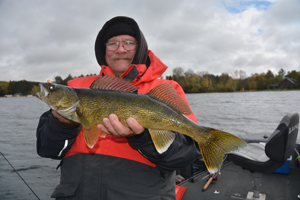 Tuesday’s surface water was either 58.9 degrees or else it was 61 degrees, depending on which instrument I used to measure it.
Tuesday’s surface water was either 58.9 degrees or else it was 61 degrees, depending on which instrument I used to measure it.
My Humminbird gives me the cooler reading and the floating pool thermometer gives me the warmer reading. In my case, the pool thermometer issues the most optimistic version of “the truth”, so I’m going with that one.
Why would I be happier with 61 vs 59 degree water temperatures? Because steadily declining surface temperatures have definitely helped trigger a noticeable increase in Walleye feeding activity. As long as walleyes are in the mood for feeding, I’d like to see the water temperatures stabilize and hold somewhere in the high 50 degree ranges for as long as possible.
Even though the research about fall turnover suggests that we don’t have a firm grip on exactly what the turnover really is, there is still no doubt that at a certain point, water temperatures do eventually get cold enough to temporarily stop the feeding frenzy.
For me, the best daytime walleye fishing occurs before the temperatures decline below 54 degrees. After that, daytime fishing enters the hit and miss phase, very much depending on weather conditions. Let’s not get too far ahead though, I don’t want to wish away a single minute of the current trend.
For my friend Marty Glackin and me, convincing Walleyes to strike was the least of our concerns on Tuesday. The conditions were ideal and that added fuel to the fire, but this was the first “easy day” that I’ve enjoyed in quite a while. The only trick to getting a strike was to toss a jig and minnow into the water, hop it a few times and try not to miss the hook set once the fish struck.
Walleyes were holding near weeds, but not necessarily in them. Although we caught some fish as deep as 20 feet and some as shallow as 12 feet, it was the slow tapering drop off between 14 to 16 feet that held the highest percentage of fish. Not every weed flat produced action, but more of them did than didn’t.
Notable too was that most of the fish preferred inside corners vs points. The best areas for us were located along the transition from a point that leads into the adjacent inside corner. I realize that will change daily depending on conditions, but it’s a good reminder how we over-focus on fishing points, overlooking corners and inside bends that can be just as good, sometimes even better.
Our presentation on Tuesday was simple, 100% of the walleyes we caught were taken with 1/8 ounce Lindy Jigs tipped with large fatheads. The fish liked orange and yellow yesterday, and we were happy to provide those options for them.
 A quick note about Crappie location is that they continue to move further way from shoreline structure, taking up residence closer to the centers of mid-lake basins. This means that finding them can be accomplished more easily, but it also means more responsibility for us anglers.
A quick note about Crappie location is that they continue to move further way from shoreline structure, taking up residence closer to the centers of mid-lake basins. This means that finding them can be accomplished more easily, but it also means more responsibility for us anglers.
On many of the area’s most popular Crappie lakes, the water that they now inhabit is too deep for safely practicing catch and release. The effects of barotrauma are well documented and the only reason for any of us to catch them in deep water is that we intend to eat them. My best advice is that we either find fish in shallower water (I’d use 25 feet or less as the benchmark), or that we bag the first 10 fish that we catch in deep water and then move on to fish for something else.
On Monday, my crew definitely had intentions of eating fish so we went ahead and fished deep water. As usual, some of the fish were larger and some were smaller, but one thing in common was that they all floated on the surface once we reeled them up. That’s why we did not attempt to release any of them; we accepted the fish that the lake was willing to give us. Luckily, most of the fish were of good size, but I did fillet a few fish that would have otherwise been released had the water been shallower.
One side note about Crappies is that they have been pressured heavily over the past few years. The gigantic 2010 year classes that occurred throughout the area have been fished down. Many of those fish that remain are of quality size and for anglers with determination; there are 12 to 14 inch fish available.
On Monday, it took all the determination I could muster, I spent several hours cruising the depths in search of a school of fish. There was more than one moment of worry about whether I should give up or not, but luckily I stumbled into the right school of fish at the right time.
If you plan to fish for Panfish this weekend, don’t be afraid to burn a few hours searching, it might seem like wasted time, but it’s not. ![]() - Jeff Sundin 218-245-9858 or EMAIL
- Jeff Sundin 218-245-9858 or EMAIL
 Lake of the Woods, LOW Tourism October 3, 2017
Lake of the Woods, LOW Tourism October 3, 2017
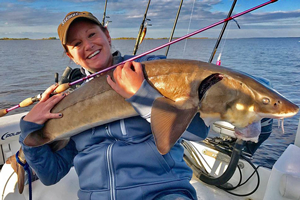 "Fishing is excellent! Walleyes in good numbers along the south shore, Long Point, Zippel Bay, Lighthouse Gap, Four Mile Bay and in river. Anglers filling livewells. Walleyes are fat, full of shiners. 18-30 feet holding fish. Anchor up with a jig with a shiner minnow. Pink, pink/white and gold have been the best colors. Reefs holding fish as well.
"Fishing is excellent! Walleyes in good numbers along the south shore, Long Point, Zippel Bay, Lighthouse Gap, Four Mile Bay and in river. Anglers filling livewells. Walleyes are fat, full of shiners. 18-30 feet holding fish. Anchor up with a jig with a shiner minnow. Pink, pink/white and gold have been the best colors. Reefs holding fish as well.
Rainy River anglers finding walleyes feeding heavily chasing shiners. Vertical jigging tipped with a shiner is best method. Some anglers trolling crankbaits with success as well. Smallmouth bass, pike and crappies showing up. Good numbers of sturgeon of all sizes being caught with some over 50" and 60".
Up at the Northwest Angle, in MN waters, jigging with pink, white or gold producing big numbers of walleyes daily. Current areas between the islands and off deep holes in 10-24 ft. Ontario crappie fishing is on fire in deeper holes off of protruding points in well known areas. Orange is the hot jig color. Muskies being caught while trolling and by unsuspecting walleye anglers." – Lake of the Woods Tourism, (800) 382-FISH
 Lake of the Woods, Border View Lodge October 3, 2017
Lake of the Woods, Border View Lodge October 3, 2017
"The water temperature in the river is getting just below 60. The daylight hours are getting shorter and we are cooling down. There are still large schools of Walleye and Shiner Minnows just outside the Lighthouse Gap.
We have spent almost all of last week on the South Shore of Big Traverse. Depths from 24-31 feet and picking a location based on the wind has been the key. Gold Strobe Jigs from Tom’s Tackle seem to be the preferred weapon, tipped with a minnow they are almost irresistible to the Walleye.
With temperatures in the 40’s and 50’s for the week ahead we see a forecast of some possible rain early in the week and a sunny weekend starting as early as Wednesday. With a full moon on Thursday and clear weather we are wondering what the Shiners will do next.
Big applause for Terry Anderson, finding a positive way to show his support and make awareness for a worthy cause. http://wjon.com/st-cloud-man-swims-across-lake-mille-lacs-video/
Our winter rates are published on our website, book early to get the best dates. Here is a great deal on Sleeper Houses for this coming winter. Make your Sleeper House reservation for a Mid-week stay by November 30th and get 10% off.... " - 1-800-776-3474 Border View Lodge .
 Jeff Sundin Fishing Report October 2, 2017 Falling Temperatures Triggering Hot Bites?
Jeff Sundin Fishing Report October 2, 2017 Falling Temperatures Triggering Hot Bites?
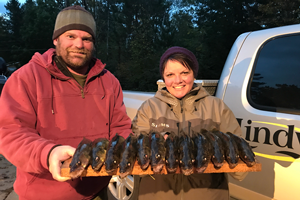 If you’ve been waiting for surface water temperatures to fall into the “ideal range” for triggering fall walleye feeding runs, then your wait is over. During the past 2 days I’ve observed the surface temperatures fall below 60 degrees, now ranging mainly between 58 and 59 degrees.
If you’ve been waiting for surface water temperatures to fall into the “ideal range” for triggering fall walleye feeding runs, then your wait is over. During the past 2 days I’ve observed the surface temperatures fall below 60 degrees, now ranging mainly between 58 and 59 degrees.
I always look forward to the annual fall fishing adventure with Chris Andresen and his pal Justin John. Unfortunately, Justin suffered an injury that forced him to sit out this trip, so this time, we did things a little differently.
Saturday’s trip was even more adventurous than usual; we fished water that was new to both of us. On Sunday, the Hippie Chick was able to fill in for Justin and thanks to her idea about re-visiting old territory for me, but another new lake for Chris. That idea was a good one, so I’ll start the report there and work backward.
In yesterday’s report I mentioned that walleyes were active, but scattered. I wrote that you’d have to be prepared to strain through a lot of water and fish multiple presentations in order to bag a respectable catch of them.
On Sunday, we saw indications that this might be changing, there were less fish in the weeds, and more fish concentrated along shoreline breaks. Admittedly, the fishing conditions were ideal, featuring a healthy chop on the water, grey skies and occasional rain showers. But for the moment, these fish behaved as if the fall feeding binge was in full force.
 The area that we fished featured a sharp drop off that lies adjacent to a shallow weedy flat. Back in June, those same weeds held good numbers of fish, but most of them were too small to be of interest to the crews I entertained at the time. At the time, there were larger fish there too, but most of them were too large and were protected by the lake’s slot limit.
The area that we fished featured a sharp drop off that lies adjacent to a shallow weedy flat. Back in June, those same weeds held good numbers of fish, but most of them were too small to be of interest to the crews I entertained at the time. At the time, there were larger fish there too, but most of them were too large and were protected by the lake’s slot limit.
This time was different; a couple inches of summer growth moved many of those fish into the ideal eating category, now ranging between 14.5 and 15 inches. There were a few 16 to 17 inch fish too, but not many, and interestingly on this trip, we didn’t catch many “slot-fish” either. This plays into the theory about the relationship between fishing under ideal conditions vs fishing during off-peak times; we will revisit that story soon.
The weed bed was thick out to about 8 feet of water, and then thinned out between 9 and 10 feet. The fish appeared to like the band of clean sand at the upper edges of the breakline between 12 and 16 feet. We marked and caught fish deeper too, but the 22 to 26 foot depth provided a home for small fish, yearlings that were about 10 inches long. Fishing in the weeds yielded a few walleyes, but contained mainly small pike.
Early in the day, my “wiggle worming” presentation held its own, nearly matching the performance of the jig and minnow combos that my crew was using. Later in the day that changed, as they got more strikes on minnows, the night crawlers became less productive. Whether I needed to or not, I joined them by switching to a 1/8 ounce Live Bait Jig tipped with a large fathead and there was a notable difference; the action picked up immediately.
As a precaution, I’ll still have crawlers on hand every day, but it looks like we could get away with jig and minnow fishing from here on out, especially during preferred fishing conditions.
The relationship between the weed edges and the steep breakline was distinct, there were fish scattered along a half mile stretch that was otherwise featureless. There weren’t any added features like submerged points, rock piles or the like. There was one pocket, an inside turn that held a few extra fish and I’ve notice fish holding in other inside corners like this one around the area; so that may be something to remember.
With the goal of finding a fresh walleye bite, I and Chris did some adventuring on Saturday. I had been doing some studying and selected a couple of lakes that offered good odds, but they were both lakes that neither of us had fished before.
Conditions were windy, but the skies were clear for most of the day. While we did bag some very nice walleyes using the same methods and fishing patterns previously mentioned, the walleye experiment was over-shadowed by Panfish, they stole the day.
After checking out a couple of weedlines and submerged points, I decided to have a look at a deep water hole, just to see if anything was there. That’s where I stumbled into some small schools of sunfish and crappies. It was just too hard to say no, even though we were on a mission for walleye, those Panfish distracted us too much and that’s where we spent the afternoon.
The small hole featured a maximum depth of 32 feet and was surrounded by slowly tapering breaklines. The Crappies preferred somewhat deeper water, and the sunfish held a little bit shallower, but at times they were mixed.
The most exceptional presentation was using a Tungsten Toad tipped with a small artificial tail. The compact bait was perfect for triggering the sunfish and they did not detract from crappie strikes at all. We only used two colors, orange/brown or yellow/red and they both worked well. I am sure that other colors would have worked too, but there was no reason to experiment.
Finding Panfish in deep water during fall is no big news, so I won’t press the subject. But I do think it’s nice to know that we can find fish without having to re-visit the same old territory too often. It encourages the idea of exploring lakes that we haven’t fished before.
All things considered, it was a darn good weekend, I'm already looking forward to next fall! - Jeff Sundin 218-245-9858 or EMAIL
"Lund Boat For Sale; Help Jeff Sell The Boat and Receive Free Fishing Trip" Jeff Sundin
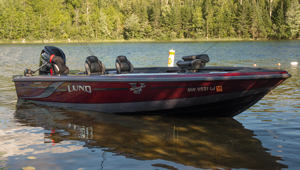 "Lund Boat, 2016 208 Pro V GL Tiller, 2016 Mercury Verado 200 HP “Big Tiller”, Lund 2016 Dual Axle Bunk Trailer.
"Lund Boat, 2016 208 Pro V GL Tiller, 2016 Mercury Verado 200 HP “Big Tiller”, Lund 2016 Dual Axle Bunk Trailer.
You've been ready for the ultimate ride in a tiller boat for a long time, but you thought it would be way too expensive for you; not anymore! It's time for me to make room for a new rig and that means that you can cash in on big savings by picking up this rigged, ready and fully trained in luxurious fishing boat.
If you’re reading this page, then you already know that I like to keep things simple and it was true when I set up this boat, my setup is for maxium efficiency as a tiller rig. It is simple but effective, leaving you a platform with plenty of space to add your own ..." Learn More >> Lund Boat For Sale
 Jeff Sundin Fishing Report October 1, 2017 - Setting Your Priorities For More Success
Jeff Sundin Fishing Report October 1, 2017 - Setting Your Priorities For More Success
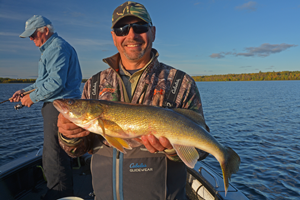 "If you’re one of the lucky anglers who are sitting on a reliable Walleye bite and if you’ve managed to keep it all to yourself, then go ahead and laugh.
"If you’re one of the lucky anglers who are sitting on a reliable Walleye bite and if you’ve managed to keep it all to yourself, then go ahead and laugh.
Compared to most typical fall walleye fishing scenarios, the action has been sluggish this year. It’s not that walleyes won’t bite, they will and they are, but they are not “stacked up” in handy one-stop locations where we can pin them down for a hot action bite. Walleyes are scattered, they inhabit a wide variety of structures and they are on the move; a tricky scenario for anglers to say the least.
For example, on Friday we caught one walleye on a deep point, in 55 feet of water in the morning. Later that day, Harry caught the accompanying gorgeous specimen in 6 feet of water over a patch of weeds. On Saturday, I dropped a wiggle worm onto the edge of a patch of green cabbage and almost instantly pulled out a 20 inch walleye while Chris Andresen was getting ready to set the hook on a fish that struck his Live Bait Jig tipped with a fathead. An hour later, we caught an 18 incher by trolling spinners tipped with night crawlers along another weed patch and by days end; we picked up still another walleye in 30 feet of water on an ice jig while we were fishing for sunfish.
The pattern is that there’s no pattern and it’s sunken into my head that if we want to catch numerous walleyes, then we have to be prepared to fish through the slow times as we search for the next active fish.
 The rub is that there are a lot of anglers out there who have been spoiled by past performances and get fidgety when the fish don’t bite right away. Once the element of doubt starts working on one’s brain, the downhill slide begins and it doesn’t take long before we begin to “expect failure”. If you recognize this happening to you, then it might be a good time to reset your priorities.
The rub is that there are a lot of anglers out there who have been spoiled by past performances and get fidgety when the fish don’t bite right away. Once the element of doubt starts working on one’s brain, the downhill slide begins and it doesn’t take long before we begin to “expect failure”. If you recognize this happening to you, then it might be a good time to reset your priorities.
We are unbelievably lucky to have such a wide array of good multi-species fishing lakes to choose from. What’s even luckier is that fishing for almost any other fish species besides walleye will pay off with fast action and good eating fish and it is all happening right now.
When given a plate of freshly fried sunfish, even the most ardent walleye purist will admit to their excellence as table fare. Perch anglers have known for a long time that there’s a lot more payoff in having a bucketful of jumbos vs a handful of eater size walleyes. Catching Crappies, our nation’s 2nd favorite fish will put a smile on anybody’s face too and it’s darn hard to beat them as the entry at the family fish fry.
On most lakes, surface temperatures have fallen below 60 degrees, just barely and it’s just a matter of time before the cooler temps trigger the walleyes into a more consistent feeding pattern. But in the meantime, there are plenty of other fish in the seas and most of them are ready, willing and able to entertain!
The takeaway from this report, I hope, is that there’s a lot to do out here and there’s still plenty of time to do it. Crappies, Sunfish, Perch and Pike are all in the mood for fall feeding and there are dozens of lakes where you can amass a healthy larder of delicious fillets.
If you are a Walleye purist, then you can still catch fish, but set your sights on working a little harder than usual. If you put in your time, exercise your creativity and remain patient, then you will catch fish.
Oh, by the way, if you’ve tried your hand at catching Panfish on one of the Itasca area’s “more-popular” lakes and have been disappointed, do not be discouraged. These well-known lakes have been heavily pressured and the fishing action shows it. If you’re willing try a couple of new lakes and aren’t afraid to use your own intuition, there’s a darn good chance that you can find your own “honey hole” out there." - Jeff Sundin 218-245-9858 or EMAILHome | Current Fishing Report | Saved Fishing Reports | Favorite Lakes | Fishing Articles Section | Recipes | Rates Services | Gift Certificates | Contact | For Sale | Links | Sitemap |
"The Early Bird Fishing Guide" Jeff Sundin - Fishing Blue Books, LLC 715 Byington Ave, LaPrairie, MN 55744 218-245-9858
Email copyright©2018 Fishing Blue Books, LLC All Rights Reserved - last revised 10-18-18